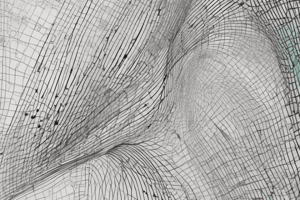Podcast
Questions and Answers
What is a relation?
What is a relation?
a set of pairs of input and output values
What is the domain of a relation?
What is the domain of a relation?
the set of all input values of a relation
What is the range of a relation?
What is the range of a relation?
the set of all output values of a relation
What is a function?
What is a function?
What is the vertical line test?
What is the vertical line test?
What is a one-to-one function?
What is a one-to-one function?
What is the horizontal line test?
What is the horizontal line test?
What is the composition of functions?
What is the composition of functions?
What are inverse functions?
What are inverse functions?
What does the domain of a function become for its inverse?
What does the domain of a function become for its inverse?
What does the range of a function become for its inverse?
What does the range of a function become for its inverse?
Do the coordinates (-3, 8) and (8, -3) represent inverse coordinates?
Do the coordinates (-3, 8) and (8, -3) represent inverse coordinates?
Do the coordinates (-2, 5) and (-5, 2) represent inverse coordinates?
Do the coordinates (-2, 5) and (-5, 2) represent inverse coordinates?
What is the inverse of the coordinate (2, -7)?
What is the inverse of the coordinate (2, -7)?
What are the steps to solve algebraically for the inverse of a function?
What are the steps to solve algebraically for the inverse of a function?
What is the inverse function, given f(x) = 2x - 16?
What is the inverse function, given f(x) = 2x - 16?
What is the inverse of the equation y = x/6?
What is the inverse of the equation y = x/6?
What is the inverse of x squared?
What is the inverse of x squared?
Flashcards are hidden until you start studying
Study Notes
Definitions and Concepts
- Relation: A set comprising pairs of input and output values.
- Domain: The complete set of all input values for a relation.
- Range: The complete set of all output values for a relation.
- Function: A specific type of relation that assigns each element from the domain to exactly one element in the range. The vertical line test is used to determine if a relation qualifies as a function.
- Vertical Line Test: Determines if a relation is a function by observing if a vertical line intersects the graph at no more than one point.
- One-to-One Function: A function type where no two different x-values correspond to the same y-value. It passes the horizontal line test.
- Horizontal Line Test: If any horizontal line intersects a graph at most once, the function has an inverse.
Function Composition and Inverses
- Composition of Functions: The action of combining two functions. Given f(x) and g(x), the composite function f(g(x)) means g is the input for f.
- Inverse Functions: Functions f and g are considered inverses if their compositions yield the identity function; that is, f(g(x)) = x and g(f(x)) = x. Their graphs reflect over the line y = x, and for ordered pairs (x, y), the inverse is (y, x). Notation for inverse function is f⁻¹(x).
Domain and Range in Inverses
- The domain of a function becomes the range in its inverse.
- The range of a function transforms into the domain in its inverse.
Inverse Coordinate Pairs
- Coordinates (-3, 8) and (8, -3) are inverse pairs.
- Coordinates (-2, 5) and (-5, 2) do not represent inverse pairs.
- The inverse of the coordinate (2, -7) is (-7, 2).
Steps for Finding Inverses Algebraically
- Replace f(x) with y in the function’s equation.
- Switch x and y.
- Solve for y.
- Substitute y back with f⁻¹(x).
Examples of Inverse Functions
- Inverse of f(x) = 2x - 16 is f⁻¹(x) = ½x + 8.
- For the function y = x/6, the inverse is f⁻¹(x) = 6x.
- The inverse of x squared is √x.
- Visual confirmation can be obtained by graphing both functions and the line y = x, demonstrating reflection.
Studying That Suits You
Use AI to generate personalized quizzes and flashcards to suit your learning preferences.




